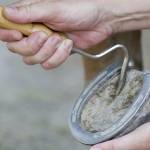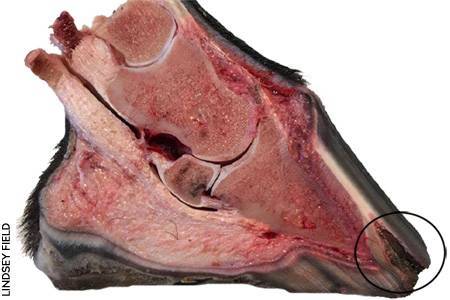White Line Disease in Horses: What Is It and What Can I Do About It?

Horse hooves bear incredible pressure, especially when asked to withstand the rigors of modern equestrian endeavors, such as three-day eventing, combined driving, or endurance riding. Despite their natural strength, all hooves are susceptible to breakdown based on a combination of mechanical stressors, environment, secondary health problems, and conformation.
For many horses, hoof integrity weakens just in front of the white line in the portion of the wall known as the stratum medium. The band of stratum medium nearest the white line is not pigmented, and it is here where separation of hoof structures causes problems. Thus, while “white line disease” is common vernacular used by professionals, it is a misnomer because the problem actually springs from disease of the adjacent tissue, not the white line itself. Separation at the stratum medium gives opportunistic bacteria or fungi the chance to proliferate and cause infection. Over time, the infection progresses deeper into the hoof toward, but never into or beyond, the coronary band.
 No single cause has been implicated in the onset of white line disease. Mechanical stressors, including misguided farriery work or poor conformation, as well as the weight-bearing problems they bring about, could initiate wall separation. Others have suggested that moisture might be a contributing factor, as excessive moisture softens hoof tissues, giving pathogens access to hoof tissue, which potentially wind up as infection. On the flip side, dry hooves often develop cracks, which may too allow pathogens to invade any fissure between the hoof wall and sole.
No single cause has been implicated in the onset of white line disease. Mechanical stressors, including misguided farriery work or poor conformation, as well as the weight-bearing problems they bring about, could initiate wall separation. Others have suggested that moisture might be a contributing factor, as excessive moisture softens hoof tissues, giving pathogens access to hoof tissue, which potentially wind up as infection. On the flip side, dry hooves often develop cracks, which may too allow pathogens to invade any fissure between the hoof wall and sole.
When white line disease first sets in, few changes in the hoof occur. Aside from slight crumbling near the white line, occasionally a powdery area may arise just behind the white line, toward the frog. The area may stay small or may gradually widen. This change is often missed by horse owners, though careful farriers will observe it. Alterations to the sole in terms of tenderness and shape may also take place. Growth of the hoof wall might slow, and disintegration of the wall could occur. When diseased wall is tapped gently with a farrier’s hammer, a hollow sound often results.
As the disease advances, the junction between the wall and the sole will widen and soften, and will often discharge a chalky powder. Lameness usually occurs once the disease has progressed to the point of severe damage and possible rotation of the coffin bone.
In addition to an examination by a farrier, assessment by a veterinarian, including high-quality radiographs, will help determine the extent of damage to the foot and will reveal if there have been changes to the coffin bone. In addition to damage assessment, radiographs serve as useful guides in the trimming and shoeing of affected horses.
Treatment of white line disease usually begins with removal of affected hoof wall followed by therapeutic shoeing designed to protect the damaged hoof. Because debridement of the hoof wall interferes with the weight-bearing capacity of the entire hoof, a shoe is typically applied for support, though the type of shoe necessary depends on the degree of damage. Daily cleaning of the debrided hoof should be performed, and topical medications can be applied as directed by a veterinarian, though many find medications unnecessary after successful debridement and routine cleaning.
During treatment, the affected hoof should remain as dry as possible, so attention should be paid to stall cleanliness and turnout situations, being careful to turn out the horse once the dew has dried and only when the paddock or pasture is free of mud.
Given that an exact cause of white line disease cannot be pinpointed, prevention revolves around scrupulous care of the hooves through daily inspection and cleaning, professional farriery, and high-quality nutrition. If white line disease occurred in part because of weak hoof walls, biotin supplementation may help. High-quality hoof supplements contain biotin and an array of other hoof-building nutrients.








